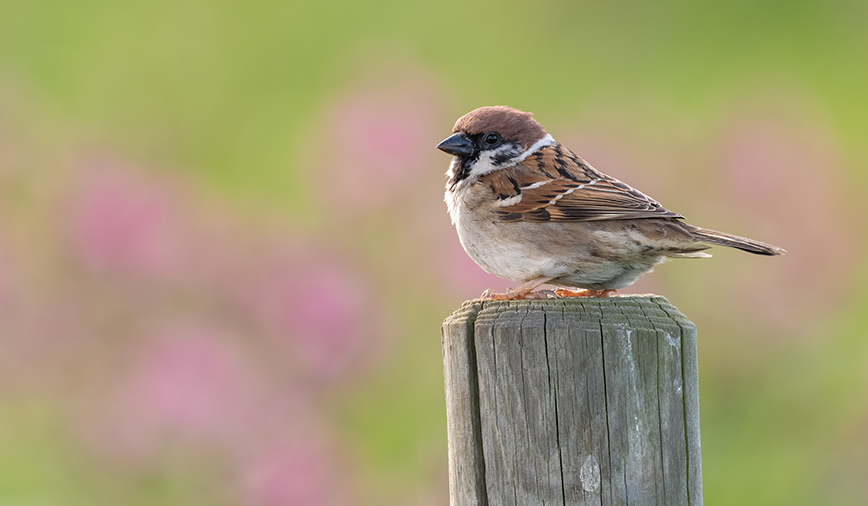Pam’s Perspective
Pam Otto is the Manager of Nature Programs and Interpretive Services for the St. Charles Park District
Whether you’re a veteran birder or brand-new to the pursuit, or even if you barely give any bird a second glance, I’ll bet at one time or another you’ve uttered the statement, “Oh, it’s a sparrow.” Or, worse, “Oh, it’s just a sparrow.”
It’s true, many of us take sparrows for granted, tending to lump all little brown seedeaters into a single category regrettably dominated by a single species, the imported English house sparrow. But all you need to do is look around to see that not all sparrows are created equal.
Take fox sparrows, for instance. Thickset and chunky yet light on their feet, they are the Chubby Checkers of the sparrow world.
If you were to line up some of the more common sparrow species in Kane County, fox sparrows would stand out for a number of reasons. For one, they’re large, at least by sparrow standards. Song sparrows, for example, (the birds you hear right now singing “Maids, maids, maids, put on your tea kettle, kettle, kettle) weigh in at around 0.7 oz. and measure 6 ¼ in. long. And the adorable little chipping sparrow (another species you might recognize by its song, a prolonged trill that sounds like a squeaky ball bearing) is only 0.4 oz. and 5 ½ in. long
Meanwhile, fox sparrows tip the scales at over an ounce, a veritable ton for a songbird, and are over 7 in. long. But what really makes these guys stand out is their unique foraging style.
Whereas most sparrows are content to pick seeds from a feeder, or delicately scratch on the ground below, fox sparrows actually do their own version of The Twist. They turn and hop, peck and jab, all the while kicking up leaf litter like there’s no tomorrow.
In fact, it was this distinctive feeding style, described as “vigorous” in field guides, that caught my attention just the other morning.
Sipping coffee and trying to clear the cobwebs (figuratively, not literally; wouldn’t want to destroy that great habitat on the kitchen ceiling) I noticed a disturbance in the backyard. Though my eyes were still sleep-blurred, I could see leaves and twigs being tossed amid a flurry of feathers. Two more chugs of coffee and a pair of binoculars later, the creators of the commotion were clear: Three chubby fox sparrows were underneath the elderberry, having breakfast.
I watched the trio for another 15minutes, until my arms got tired of holding the binocs and the coffee ran out. I grabbed the camera, took a couple pictures, then headed out to start my day.
If you’d like to spot some fox sparrows of your own, look for shrubby, wooded areas with lots with lots of leaf litter on the ground. Morning and evening, just before sunset, are good times to catch these characters displaying their vigorous feeding techniques.
But you’d better hurry! Fox sparrows typically only stay in our area until about mid- April, at which time they leave for their breeding grounds up north.
If you should happen to see one, or two or three, count yourself lucky. And instead of saying, “Oh, it’s just a sparrow,” change your tune a bit to “Oh! It’s a fox sparrow,” a bird with few equals.
Pam Otto, a vigorous forager herself, is the manager of nature programs and interpretive services for the St. Charles Park District. She can be reached at 630-513-4346 or potto@stcparks.org.

